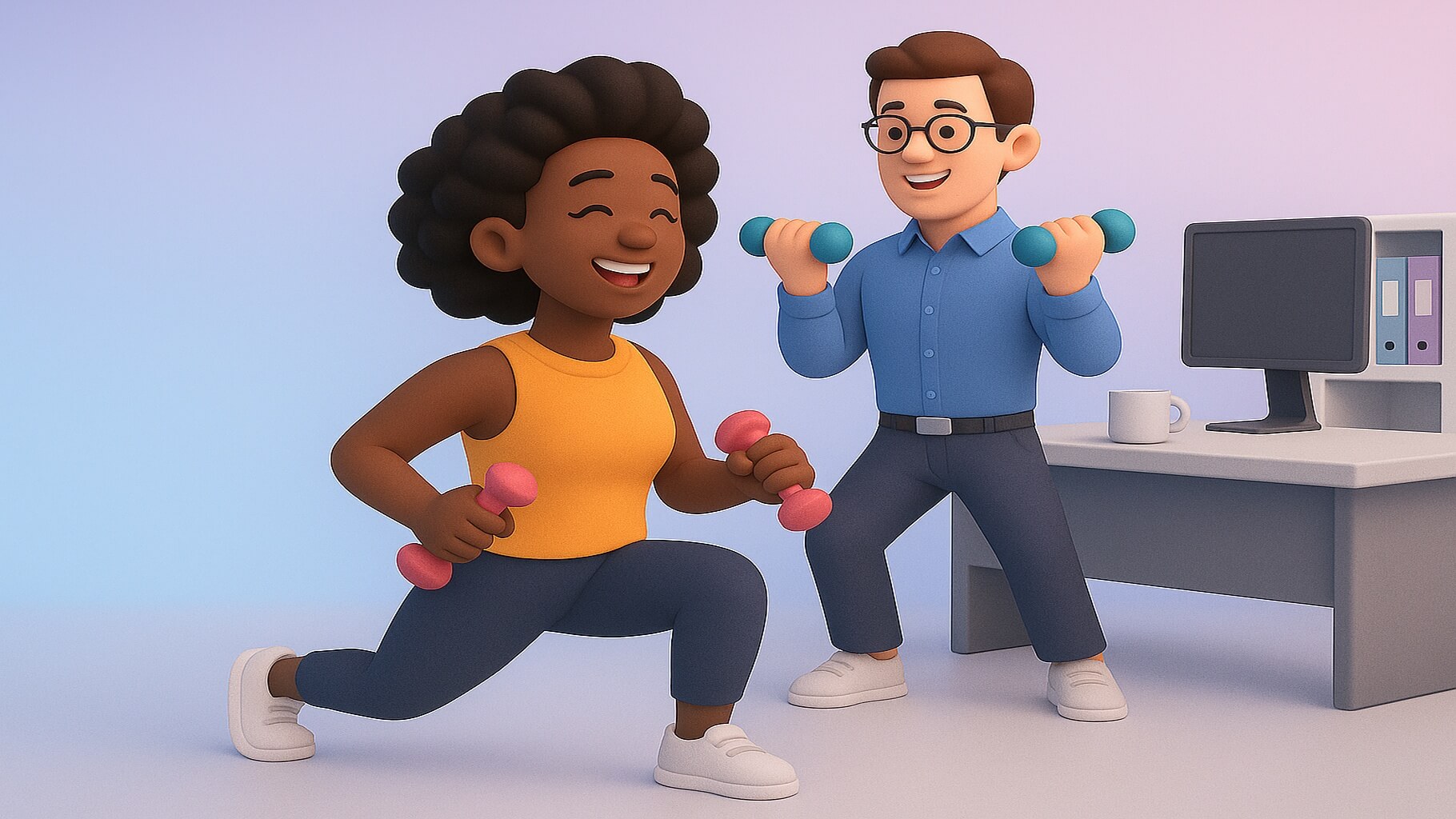
Creating a workplace where employees thrive requires more than competitive salaries and benefits. At Matter, we understand that fostering genuine well-being means addressing the whole person through thoughtful wellness initiatives that inspire participation and build lasting healthy habits. Organizations today face the complex task of designing wellness programs that resonate with diverse teams while driving meaningful engagement and supporting overall health.
The most successful wellness initiatives go beyond generic fitness trackers or one-size-fits-all approaches. They create inclusive experiences that celebrate progress at every level, encourage team collaboration, and align with company culture. This comprehensive guide explores over 37 proven wellness challenge ideas designed to boost employee engagement, improve physical and mental health, and cultivate a thriving workplace where everyone feels supported on their well-being journey.
What are employee wellness challenges, and why do they matter?

Employee wellness challenges are structured programs designed to encourage healthy behaviors and improve overall well-being through engaging activities and friendly competition. These initiatives range from simple step-counting contests to comprehensive programs addressing physical health, mental wellness, and financial well-being. When employees have chances to support one another and build behaviors that benefit the company and themselves, it's a recipe for success for a wellness program in the workplace.
Modern wellness programs have evolved significantly from basic gym membership subsidies. Today's successful wellness challenge incorporates elements such as team-based challenges, technology integration, and personalized goals that accommodate different fitness levels and abilities. Organizations implementing these programs report improved employee morale, reduced health care costs, and stronger workplace connections that extend beyond the challenge period.
Understanding the impact of wellness challenges for employees
Employee wellness programs create transformative changes that ripple through entire organizations. When designed thoughtfully, these initiatives address multiple dimensions of well-being while fostering connections among team members who face various employee engagement challenges in their daily work.
The impact of wellness initiatives extends far beyond physical fitness improvements:
- Enhanced mental health support: Challenges incorporating mindfulness, stress management, and emotional health components help employees develop coping strategies for workplace pressures while supporting their mental well-being
- Stronger team bonds: Group activities and accountability partners create natural opportunities for colleagues to connect outside traditional work contexts
- Increased productivity: Employees who engage in regular wellness activities report higher energy levels and improved focus during work hours
- Cultural transformation: Regular wellness programs signal organizational commitment to employee wellbeing, strengthening company culture
- Long-term behavior change: Structured challenges help all the employees establish healthy habits that persist beyond the program duration
How do employee wellness challenges benefit organizations?
Organizations investing in comprehensive employee wellness programs see measurable returns across multiple business metrics. These benefits extend beyond reduced healthcare costs to encompass improved performance, employee retention, and a positive workplace culture. Many wellness programs now demonstrate clear ROI through decreased absenteeism and improved productivity metrics.
Strategic wellness challenge implementation delivers significant organizational advantages:
- Decreased absenteeism: Healthy employees utilize fewer sick days, ensuring consistent production and team cohesion while lowering healthcare expenses.
- Lower healthcare expenses: Preventive wellness initiatives help reduce chronic diseases and associated medical costs over time
- Enhanced recruitment appeal: Strong wellness programs attract top talent seeking employers who prioritize employee wellbeing and offer comprehensive wellness services
- Improved employee retention: Workers who feel supported in their wellness journey demonstrate higher loyalty and job satisfaction
- Positive brand reputation: Companies known for excellent wellness programs enhance their employer brand and community standing
The connection between wellness and employee productivity
The relationship between employee health and workplace performance creates a compelling case for comprehensive wellness programs. Research consistently demonstrates that employees who engage in wellness activities exhibit enhanced work quality and higher levels of engagement. Physical and mental health have a direct influence on workplace effectiveness through several key mechanisms.
Strategic wellness initiatives that support overall health deliver measurable productivity improvements:
- Energy management: Regular physical activity and healthy eating habits provide sustained energy throughout the workday
- Stress resilience: Such a program teaching stress management techniques helps employees navigate workplace challenges more effectively
- Cognitive function: Exercise and proper nutrition support brain health, enhancing problem-solving and creative thinking abilities
- Emotional stability: Mental wellness support helps employees maintain positive attitudes and constructive workplace relationships, which increases employee morale
- Focus improvement: Healthy lifestyle choices reduce distractions from health concerns, allowing greater concentration on work tasks
10 fun employee wellness challenges that drive participation

Creating excitement around workplace wellness challenges requires innovative approaches that make healthy behaviors enjoyable rather than obligatory. The most successful programs transform wellness from a chore into an anticipated activity that employees actively discuss and celebrate. These fun team challenges combine entertainment with health benefits, ensuring high participation rates while fostering lasting habits that enhance both physical fitness and mental well-being.
10 engaging wellness challenge ideas that employees love:
- Office Olympics: Transform your workplace into an athletic arena with mini-competitions like chair races, paper airplane contests, and desktop basketball
- Smoothie recipe swap: Encourage employees to share and rate healthy meal smoothie creations, with weekly taste-testing sessions and recipe cards
- Desk yoga tournaments: Host 15-minute guided stretching sessions with playful competitions for the most creative poses or best team synchronization
- Healthy potluck championships: Organize monthly themed potlucks where teams compete to create the most nutritious and delicious dishes featuring healthy food choices
- Walking meeting challenges: Replace traditional conference room gatherings with walking meetings, sitting alternatives, tracking collective miles, and creative routes
- Mindfulness moments competition: Create daily 5-minute meditation breaks with themed visualizations and relaxation techniques that promote mindfulness
- Water intake relay races: Form teams competing to meet daily hydration goals using creative tracking methods and celebration rituals
- Stairway to fitness: Track stair climbing throughout buildings, creating virtual mountain climbing achievements and team milestones
- Lunch hour dance parties: Schedule weekly dance sessions featuring different music genres and simple choreography for all skill levels
- Sleep quality championships: Encourage healthy sleep habits through sleep tracking competitions and sharing of effective bedtime routines
Creative physical activity challenges
Physical fitness challenges succeed when they accommodate diverse abilities while maintaining excitement and friendly competition. The key lies in designing office exercise challenges that feel more like play than exercise, encouraging consistent participation across all fitness levels and physical abilities.
Innovative approaches to physical wellness include:
- Adventure mapping: Create virtual journeys where steps translate to progress along famous trails or landmarks, with teams racing to reach destinations
- Fitness bingo cards: Design customizable cards featuring varied activities like "take a stretch break" or "try a new healthy recipe" for weekly completion
- Movement multiplier days: Designate special days where certain activities earn bonus points, keeping engagement fresh and unpredictable to motivate participants
- Photo scavenger hunts: Combine physical activity with creativity by challenging teams to photograph themselves completing wellness tasks around the office
- Reverse fitness challenges: Instead of competing for most steps, create challenges for best form, most creative exercise location, or most inspiring workout playlist.
Fun employee wellness challenges for all fitness levels
Inclusivity remains paramount when designing wellness activities that engage every employee regardless of physical abilities or current fitness status. Successful employee fitness challenges offer multiple participation pathways, celebrating all forms of progress to enhance company culture and foster a sense of community.
Key strategies for inclusive challenge design include:
- Choice-based activities: Offer multiple ways to earn points, allowing participants to select activities matching their comfort and ability levels while respecting different physical abilities
- Effort-based scoring: Reward consistency and improvement rather than absolute performance, recognizing individual progress journeys
- Team balance requirements: Structure teams to include diverse fitness levels, encouraging peer support, and collective success
- Modified activity options: Provide seated, low-impact, or shortened versions of all physical challenges to ensure universal access
- Non-physical alternatives: Include mental wellness, nutrition, and sleep-focused options, earning equal recognition as physical activities
Gamified wellness experiences that engage
Gamification transforms routine wellness activities into engaging experiences that motivate participants through friendly competition and recognition of achievement. These wellness challenge ideas leverage game design principles to sustain long-term engagement and help employees stay engaged effectively.
Effective gamification strategies include:
- Level progression systems: Create tiers of achievement that unlock new challenges and reward participation as participants advance through wellness milestones
- Virtual wellness currencies: Implement point systems where healthy behaviors earn currency redeemable for prizes or charitable giving options
- Team quest narratives: Develop storylines where collective wellness activities advance teams through adventure scenarios or mystery solving
- Badge collections: Design digital or physical badges recognizing specific achievements like "Hydration Hero" or "Mindfulness Master" to encourage healthy living
- Leaderboard variations: Rotate different ranking categories weekly, highlighting various aspects like most improved, best team spirit, or creative participation
8 inclusive employee wellness challenges for diverse teams

Building truly inclusive wellness programs requires thoughtful consideration of diverse backgrounds, abilities, and personal circumstances. The most impactful employee wellness challenge ideas create opportunities for everyone to participate meaningfully, regardless of physical limitations, cultural considerations, or personal preferences. These programs demonstrate organizational commitment to supporting all employees in their unique wellness journeys while addressing potential team challenges that arise from diversity.
8 inclusive wellness challenges that welcome everyone:
- Gratitude journal circles: Encourage daily gratitude practices with weekly sharing sessions that build emotional health and team connections through a structured gratitude challenge
- Cultural cuisine exploration: Celebrate diverse healthy eating traditions by featuring different cultural approaches to nutritious meals and healthy snacks each month
- Flexible fitness hours: Provide wellness activities at diverse times and formats to cater to varying schedules and preferences.
- Mental health check-in challenges: Normalize mental wellness discussions through structured programs, encouraging open dialogue and support
- Financial wellness workshops: Address financial well-being through budgeting challenges and savings goal competitions
- Community service wellness: Combine physical activity with charitable giving through volunteer opportunities and charity challenges
- Digital detox challenges: Promote mental well-being by encouraging periodic breaks from technology and social media to support work-life balance
- Adaptive movement programs: Design activities specifically accommodating various physical abilities and mobility levels
Designing accessible wellness programs for everyone
Creating wellness initiatives that truly serve all employees requires intentional design focusing on accessibility from the outset. Successful office wellness challenges recognize that wellness looks different for everyone and provide multiple pathways to participation while maintaining environmental awareness.
Essential accessibility considerations include:
- Multiple format options: Offer in-person, virtual, and self-paced alternatives for all wellness activities to accommodate different needs
- Clear communication channels: Provide program information through various mediums, including visual, audio, and written formats
- Flexible timing structures: Allow participants to complete challenges within broader timeframes rather than rigid daily requirements
- Equipment-free options: Ensure all challenges can be completed without specialized equipment or gym access
- Confidential participation paths: Create private tracking options for employees who prefer not to share progress publicly
Cultural considerations in inclusive employee wellness challenges
Respecting cultural diversity within wellness programs strengthens participation and demonstrates genuine organizational inclusivity. Programs must navigate different cultural attitudes toward health, exercise, and public participation while creating welcoming environments for all, particularly when managing virtual team challenges across global offices.
Key cultural considerations include:
- Dietary respect: Design nutrition challenges accommodating various dietary restrictions, religious requirements, and cultural food preferences
- Modesty accommodations: Provide exercise options respecting different comfort levels, with physical activity visibility and clothing requirements
- Holiday awareness: Schedule challenges considering major cultural and religious observances to ensure equitable participation opportunities
- Language accessibility: Offer wellness materials and communications in multiple languages reflecting workforce diversity
- Cultural wellness practices: Incorporate diverse wellness traditions like tai chi, yoga, and meditation styles from various cultures
Adapting challenges for different abilities and needs
True inclusivity means designing wellness challenges that allow employees with varying physical and cognitive abilities to participate fully and meaningfully. This approach benefits everyone by creating more creative and flexible wellness solutions that address various employee challenges.
Adaptation strategies for universal participation:
- Equivalent alternatives: For every physical challenge, provide mental, social, or nutritional alternatives, earning equal recognition
- Customizable goals: Allow participants to set personal targets based on individual baselines rather than universal standards
- Assistive technology integration: Incorporate apps and tools that support participants with different abilities in tracking and participating
- Peer support systems: Create buddy programs pairing employees to provide mutual encouragement and practical assistance
- Progress celebration: Recognize effort and improvement rather than absolute achievement, validating all forms of wellness progress
7 employee wellness team challenges that build connections

Team-based wellness initiatives provide powerful opportunities for relationship building while collectively pursuing health goals. These team workout challenges transform individual wellness journeys into shared experiences that strengthen workplace bonds. When colleagues support each other's physical well-being and healthy behaviors, they develop deeper trust and communication, which enhances the overall workplace culture and collaboration.
7 team wellness challenges that unite and inspire:
- Department relay races: Create ongoing competitions where team members take turns completing daily wellness tasks to advance collective goals
- Wellness buddy systems: Pair employees as accountability partners who check in daily and celebrate each other's progress toward healthy habits
- Cross-functional fitness quests: Mix departments in teams tackling progressive challenges that require diverse skills and perspectives
- Healthy habit chains: Teams work together, maintaining streaks of positive behaviors, with each member's participation crucial for success
- Virtual wellness journeys: Groups collectively accumulate activity to travel virtual routes, unlocking cultural education at each destination
- Team transformation challenges: Departments choose collective goals like reducing meeting sitting time or increasing water consumption
- Peer recognition wellness: Combine wellness activities with appreciation, where team members acknowledge each other's healthy choices
Collaborative wellness goals for departments
Departmental wellness challenges create unique opportunities for teams that already work together to strengthen bonds through shared health initiatives. These programs leverage existing relationships while building new dimensions of mutual support and addressing how to handle team challenges in wellness contexts.
Effective departmental challenge strategies:
- Collective milestone tracking: Set department-wide goals where everyone's contribution matters, fostering shared ownership of outcomes
- Rotating leadership roles: Facilitate various team members to oversee weekly activities, enhancing leadership competencies while disseminating wellness expertise.
- Department wellness meetings: Integrate brief wellness check-ins into regular team meetings, normalizing health discussions
- Workspace wellness improvements: Challenge departments to collectively enhance their physical environment with plants, standing options, or relaxation spaces
- Success story sharing: Create forums for departments to share their wellness wins and strategies with the broader organization, helping challenge winners inspire others
Employee wellness team challenges that foster unity
The most effective team challenges create lasting connections that extend beyond the program duration. These initiatives foster trust and understanding among colleagues while pursuing wellness goals together, which is particularly important for addressing challenges in remote team settings within distributed workforces.
Unity-building challenge elements:
- Mixed-ability team requirements: Structure teams ensuring diverse fitness levels work together, promoting mutual support over competition
- Collaborative goal setting: Have teams collectively decide their wellness targets, building consensus and shared commitment
- Team celebration rituals: Establish regular recognition moments where teams acknowledge both individual and collective progress
- Peer coaching programs: Encourage team members to share expertise, whether in nutrition, exercise techniques, or stress management
- Shared experience activities: Include challenges requiring in-person or virtual group participation, like team cooking classes featuring healthy recipes or group meditation
Cross-functional wellness competitions
Breaking down organizational silos through wellness initiatives yields unexpected benefits that extend beyond health improvements. Cross-functional challenges encourage employees to build relationships across departments while pursuing common wellness goals and developing strategies to address various office challenges.
Benefits of cross-functional wellness programs:
- Enhanced communication: Employees develop informal communication channels that improve workplace collaboration
- Perspective sharing: Participants gain understanding of different departmental challenges and workflows through wellness conversations
- Innovation opportunities: Diverse teams often develop creative solutions to wellness challenges that benefit the entire organization
- Network expansion: Employees build relationships beyond their immediate teams, strengthening organizational cohesion
- Culture reinforcement: Cross-functional activities reinforce company values and create shared experiences across hierarchical levels
6 corporate wellness challenges and employee engagement strategies

Strategic corporate wellness challenges align health initiatives with broader organizational goals while maximizing employee engagement. The key to the success of these programs is the active participation of leadership and the incorporation of health into the organizational culture. The most effective approaches integrate wellness into daily workflows rather than treating it as an add-on activity, helping organizations overcome common fun office challenges while promoting health.
6 corporate wellness strategies that drive engagement:
- Executive wellness ambassadors: Senior leaders champion specific wellness initiatives, participating visibly and sharing personal wellness journeys
- Wellness-linked recognition programs: Integrate wellness achievements into existing employee recognition systems and performance discussions
- Company-wide wellness days: Designate quarterly days focused entirely on employee wellbeing with special activities and workshops
- Wellness committee empowerment: Establish employee-led committees with budgets and authority to implement creative wellness initiatives
- Success metrics transparency: Share aggregate wellness program data showing participation rates and health improvements across the organization
- Wellness culture awards: Recognize departments and teams exemplifying strong wellness cultures through peer nominations and measurable outcomes
Aligning wellness with company culture
Successful wellness programs reflect and reinforce organizational values while addressing specific workforce needs. This alignment ensures wellness initiatives feel authentic rather than imposed, increasing voluntary participation and long-term success. Strong workplace wellness programs become an integral part of an organization's identity.
Culture alignment strategies include:
- Value integration: Design challenges that demonstrate company values like collaboration, innovation, or community service through wellness activities
- Brand consistency: Ensure wellness communications and activities reflect the company's brand personality and messaging tone
- Mission connection: Link wellness goals to organizational mission, showing how healthy employees advance company purpose
- Cultural rituals: Incorporate wellness into existing company traditions and celebrations, making health part of organizational identity
- Feedback loops: Regularly gather employee input, ensuring wellness programs evolve with changing cultural needs
Leadership participation in corporate wellness challenges
Leadership involvement transforms wellness programs from HR initiatives into organizational priorities. When executives actively participate in workplace fitness challenges, they signal a genuine commitment to employee well-being while modeling healthy behaviors.
Effective leadership engagement approaches:
- Visible participation: Leaders join challenges alongside employees, sharing progress and challenges authentically
- Personal story sharing: Executives discuss their wellness journeys, including struggles and successes, humanizing leadership.
- Resource commitment: Leadership allocates adequate budgets and time for wellness activities, demonstrating tangible support
- Policy alignment: Ensure company policies support wellness goals, such as flexible schedules for exercise or healthy meeting food options
- Recognition involvement: Leaders personally acknowledge wellness achievements, reinforcing program importance
Measuring employee engagement in wellness challenges
Quantifying the success of a wellness program requires comprehensive metrics beyond simple participation rates. Effective measurement strategies capture both immediate engagement and long-term behavioral changes, while informing program improvements and demonstrating their impact on job satisfaction.
Key measurement approaches include:
- Multi-dimensional tracking: Monitor participation frequency, activity variety, and sustained engagement over time
- Qualitative feedback: Gather stories and testimonials capturing personal impacts beyond numerical metrics
- Health outcome correlation: Track connections between wellness participation and health indicators like reduced sick days
- Engagement quality metrics: Measure depth of participation through completion rates and challenge progression
- Cultural impact assessment: Evaluate how wellness programs influence the overall workplace atmosphere and employee satisfaction
6 innovative employee wellness program challenges ideas

Innovation in workplace wellness keeps programs fresh and engaging while addressing the evolving needs of employees. These cutting-edge employee wellness challenge ideas leverage technology, holistic health approaches, and creative themes to maintain excitement throughout the year. The most successful programs anticipate trends while remaining grounded in proven wellness principles that support financial wellness alongside physical health.
6 innovative wellness challenges for modern workplaces:
- AI-powered wellness coaching: Implement personalized wellness apps providing individual guidance based on employee goals and progress
- Virtual reality meditation spaces: Create immersive relaxation experiences using VR technology for stress management and mental wellness
- Biometric feedback challenges: Use wearable devices tracking heart rate variability and sleep quality to gamify recovery and stress reduction
- Microhabitat challenges: Focus on tiny daily changes like one-minute breathing exercises or single healthy food swaps
- Reverse wellness auctions: Employees bid wellness points to win experiences promoting work-life balance and personal growth.
- Wellness hackathons: Teams compete to develop innovative solutions for common workplace wellness obstacles
Technology-driven wellness solutions
Modern wellness programs leverage technology to deliver personalized experiences while fostering human connection. These solutions make participation convenient while providing rich data for program optimization and helping organizations implement comprehensive employee wellness programs.
Technology integration strategies:
- Mobile-first design: Ensure all wellness activities are accessible through smartphones, meeting employees where they spend time
- Wearable device integration: Connect popular fitness trackers and smartwatches to automatically track physical activity and sleep patterns
- Gamification platforms: Use specialized wellness apps to create engaging experiences with points, badges, and social features
- Virtual coaching access: Provide on-demand access to nutritionists, fitness instructors, and mental health professionals through digital platforms
- Data visualization tools: Create compelling dashboards showing individual and team progress in engaging visual formats
Holistic employee wellness challenges ideas
Comprehensive wellness encompasses all aspects of human health, acknowledging the interconnections between physical, mental, emotional, and financial well-being. These programs foster sustainable lifestyle changes rather than temporary fixes, addressing multiple health behaviors simultaneously.
Holistic wellness program components:
- Integrated challenge design: Create programs simultaneously addressing multiple wellness dimensions through connected activities
- Life balance focus: Include challenges promoting work-life balance through time management and boundary-setting exercises
- Environmental wellness: Incorporate sustainability challenges, connecting personal health with environmental awareness
- Social wellness emphasis: Design activities strengthening workplace relationships and community connections
- Purpose-driven wellness: Link health activities to personal values and life goals, creating deeper motivation
Seasonal and themed wellness programs
Seasonal wellness challenges maintain year-round engagement by aligning activities with natural rhythms and cultural moments. These programs prevent wellness fatigue while providing fresh motivation regularly, particularly effective for office fitness challenges that might otherwise become routine.
Seasonal programming ideas:
- Spring renewal challenges: Focus on fresh starts with outdoor activities and healthy meal planning using seasonal produce
- Summer activity adventures: Leverage longer days for evening wellness activities and team outdoor excursions
- Fall preparation programs: Emphasize immune system strengthening and establishing routines before the holiday season
- Winter wellness focus: Address seasonal mood changes through light therapy challenges and warming movement activities
- Holiday navigation challenges: Provide strategies for maintaining healthy habits during celebration seasons without sacrificing enjoyment
How to maximize employee engagement in wellness challenges

Sustaining high participation in wellness programs requires strategic communication, meaningful incentives, and careful attention to fostering long-term habits. The most successful wellness initiatives create environments where employees feel genuinely supported rather than pressured to participate. Organizations must strike a balance between encouraging individual choices and respecting them, while removing barriers to participation and offering suitable wellness incentives.
Building engagement starts with understanding employee motivations and addressing common participation obstacles. When wellness challenges align with what employees want and need, engagement follows naturally. This approach transforms wellness from an obligation into an opportunity that employees actively seek out and discuss positively with colleagues.
Communication strategies for wellness participation
Effective wellness communication goes beyond simple program announcements to create ongoing dialogue about health and well-being. Strategic messaging inspires participation while respecting individual privacy and choices, encouraging employees without creating pressure.
Key communication approaches that engage employees:
- Multi-channel messaging: Utilize email, instant messaging, physical posters, and team meetings to reach employees through their preferred communication methods
- Peer storytelling: Share authentic success stories from employees at various wellness stages, making progress feel attainable for everyone
- Progress visualization: Create compelling infographics and dashboards showing collective achievements and individual milestone celebrations
- Curiosity-driven content: Share interesting wellness facts and tips that educate while entertaining, building wellness knowledge gradually
- Two-way dialogue: Establish feedback channels where employees shape program evolution through suggestions and honest input
Incentives that motivate without excluding
Meaningful wellness incentives encourage participation while avoiding the creation of have and have-not dynamics within organizations. The best reward structures celebrate effort and progress rather than just outcomes, ensuring all employees feel valued.
Inclusive incentive strategies include:
- Participation-based rewards: Offer wellness incentives for consistent engagement regardless of performance levels or health outcomes
- Choice-driven prizes: Provide diverse reward options from gift cards to charitable donations to extra time off
- Team achievement bonuses: Structure rewards encouraging collective success while recognizing individual contributions
- Non-monetary recognition: Create meaningful acknowledgment through public appreciation, special privileges, or professional development opportunities
- Surprise elements: Include unexpected rewards for random participants, keeping engagement fresh and equitable
Creating sustainable wellness habits beyond challenges
The ultimate goal of any wellness challenge is to extend beyond temporary participation to establish lasting behavioral changes. Successful programs establish frameworks that support continued wellness engagement after formal challenges conclude, ensuring that healthy employees maintain their progress.
Sustainability strategies for long-term wellness:
- Gradual progression design: Structure challenges building skills incrementally, avoiding overwhelming participants with dramatic changes
- Habit stacking techniques: Connect new wellness behaviors to existing routines, making healthy choices feel natural
- Community building focus: Foster wellness relationships that continue supporting healthy behaviors after programs conclude
- Resource provision: Offer tools, guides, and ongoing support, helping employees maintain wellness momentum independently
- Evolution pathways: Provide advanced challenges for completed participants, maintaining engagement through continued growth opportunities
Implementing successful employee wellness challenges

Launching effective workplace wellness programs requires careful planning, realistic timelines, and systems for measuring success. Organizations must balance ambition with achievability while creating structures supporting long-term wellness culture development. The most successful implementations start small, learn quickly, and scale based on employee feedback and demonstrated results to create a successful wellness challenge framework.
Strategic implementation transforms good wellness ideas into thriving programs that genuinely improve employee health and organizational culture. This process requires commitment from leadership, adequate resources, and patience as wellness habits develop over time. Organizations that achieve remarkable results view wellness not as an endpoint but as a means to an end, recognizing that lasting transformation requires time.
How long should wellness challenges for employees run?
The program duration has a significant impact on both participation rates and the effectiveness of behavior change. The ideal challenge length strikes a balance between maintaining excitement and providing sufficient time for habit formation, while avoiding wellness fatigue.
Duration considerations for optimal results:
- Short sprints (2-4 weeks): Ideal for introducing new concepts, testing program ideas, or maintaining variety throughout the year
- Standard challenges (6-8 weeks): Provide enough time for habit formation while maintaining engagement momentum
- Extended programs (3-6 months): Best for comprehensive lifestyle changes requiring sustained support and gradual progression
- Ongoing initiatives: Create perpetual wellness cultures through continuous programming with regular refresh points
- Flexible timeframes: Allow participants to complete challenges at their own pace within broader program windows
Tracking and measuring wellness challenge success
Comprehensive measurement approaches capture both quantitative metrics and qualitative impacts of wellness programs. Effective tracking systems provide insights for program improvement while celebrating participant achievements and demonstrating ROI for wellness committee stakeholders.
Essential measurement strategies include:
- Baseline establishment: Collect initial health metrics and engagement data before program launch for accurate comparison
- Multi-metric dashboards: Track participation rates, activity completion, health improvements, and satisfaction scores simultaneously
- Anonymous feedback systems: Gather honest input about program effectiveness through confidential surveys and suggestion boxes
- ROI calculations: Measure program returns through reduced absenteeism, healthcare cost changes, and productivity indicators
- Story collection: Document personal transformation narratives providing context for numerical data and inspiring continued participation
Common pitfalls in employee wellness challenge ideas
Understanding potential obstacles helps organizations design more effective wellness programs from the start. Learning from common mistakes prevents discouragement and builds stronger foundations for wellness success while avoiding issues that unnecessarily challenge employees.
Pitfalls to avoid in wellness programming:
- One-size-fits-all approaches: Failing to accommodate diverse needs and preferences limits participation and effectiveness
- Complexity overload: Creating overly complicated tracking systems or rules discourages participation from busy employees
- Inadequate communication: Assuming employees understand program details without clear, repeated messaging leads to confusion
- Competition focus: Overemphasizing winners and losers alienates less competitive employees and those starting from different baselines
- Sustainability neglect: Focusing solely on challenge periods without planning for post-program support wastes momentum
How Matter amplifies employee wellness challenge success
Matter transforms workplace wellness initiatives by seamlessly integrating recognition and appreciation into health-focused programs. The platform's unique approach combines peer-to-peer acknowledgment with wellness tracking, creating comprehensive solutions that address both physical health and emotional well-being. When employees receive recognition for wellness efforts through Matter's intuitive interface, it reinforces positive behaviors while building supportive workplace communities.
The platform's Slack and Teams integration ensures wellness recognition happens naturally within existing workflows. Employees can celebrate each other's healthy choices, milestone achievements, and consistent participation without leaving their primary communication tools. This seamless experience enhances engagement while incorporating appreciation for wellness into the daily workplace culture.
Integrating recognition with wellness initiatives
Matter's recognition features create powerful reinforcement mechanisms for wellness behaviors. When colleagues acknowledge each other's health efforts, it fosters accountability and encouragement that sustain long-term participation in all wellness activities.
Recognition integration benefits through Matter:
- Real-time wellness kudos: Employees send customized recognition cards celebrating wellness achievements instantly through Slack or Teams
- Milestone automation: Matter automatically recognizes wellness anniversaries and achievement thresholds, ensuring no success goes unnoticed
- Values alignment: Wellness recognition connects to company values, reinforcing how healthy employees contribute to organizational success
- Peer motivation: Visible recognition creates positive peer pressure, encouraging others to participate in wellness activities
- Reward flexibility: Matter's coin system allows wellness achievements to earn tangible rewards, from gift cards to charitable donations
Real-time tracking of wellness participation
Matter's analytics capabilities offer comprehensive insights into the effectiveness of wellness programs while maintaining individual privacy. Organizations gain valuable data for program optimization while employees enjoy seamless participation tracking through integrated wellness services.
Tracking features enhancing wellness programs:
- Automated participation logging: Integration with workplace tools automatically captures wellness activity participation without manual entry
- Progress visualization: Clear dashboards show individual and team wellness journey progression in engaging formats
- Trend identification: Analytics reveal which wellness activities generate the highest engagement, informing future program design
- Custom report generation: Create detailed reports for leadership showing wellness program ROI and employee engagement metrics
- Privacy protection: Anonymous aggregate data protects individual information while providing organizational insights
Building wellness culture through peer appreciation
Matter's peer recognition framework fosters lasting wellness cultures by incorporating health celebrations into everyday workplace interactions. This approach transforms wellness from individual pursuits into collective achievements worth celebrating, ultimately promoting mindfulness and healthy living throughout the organization.
Culture-building features within Matter:
- Feedback Friday wellness: Automated weekly prompts encourage employees to recognize colleagues' wellness efforts and progress
- Team wellness walls: Dedicated channels showcase wellness wins, creating inspiration and friendly competition
- Inclusive recognition options: Multiple ways to acknowledge wellness efforts ensure all participation styles receive appreciation
- Leadership visibility: Executives can easily participate in wellness recognition, modeling healthy behavior, and appreciation
- Long-term habit reinforcement: Consistent peer recognition for wellness choices helps establish permanent healthy behaviors
FAQs about employee wellness challenges
Clear answers to common questions help organizations design and implement effective wellness programs while addressing employee concerns. These insights are derived from successful implementations across various industries and company sizes.
Q: What are the most effective wellness challenges?
A: The most effective wellness challenges combine physical activity, mental health support, and social connection while accommodating diverse abilities and preferences. Programs showing the highest engagement include walking challenges with team components, mindfulness programs with daily check-ins, and nutrition initiatives featuring group cooking classes or healthy recipe exchanges. Success depends more on inclusive design and consistent communication than on specific types of activities.
Q: How to ensure inclusivity in wellness programs?
A: Ensure inclusivity by offering multiple participation pathways for every challenge, accommodating different physical abilities, cultural backgrounds, and personal circumstances. Provide non-physical alternatives that earn equal recognition and respect, while considering dietary and religious needs, and allowing for flexible scheduling. Create anonymous participation options and avoid public weigh-ins or fitness measurements that might discourage some employees.
Q: Best practices for remote employee wellness
A: Remote employee wellness thrives through virtual team challenges, online wellness workshops, and digital recognition platforms. Schedule wellness activities across different time zones, provide stipends for home exercise equipment, and create virtual coffee breaks to promote social wellness. Use video platforms for group fitness classes and meditation sessions while leveraging apps for easy progress tracking and peer encouragement.
Q: How much budget should companies allocate for employee wellness challenges?
A: Successful wellness programs can be implemented with budgets ranging from $0 to $200 per employee annually, though this varies based on company size and program scope. Many effective challenges require minimal investment, focusing instead on the creative use of existing resources, peer recognition, and free activities such as walking groups or mindfulness sessions. Companies often see an ROI of 3:1 or higher through reduced healthcare costs and improved productivity.
Q: What if employee participation in wellness challenges remains low?
A: Low participation often stems from poor communication, inconvenient timing, or programs that don't match employee interests. Address this by surveying employees about preferred activities and barriers, offering flexible participation options, and starting with small pilot programs to build momentum. Focus on making wellness activities fun and social rather than obligatory, and ensure leadership visibly participates to signal organizational support.
Q: Can small companies implement effective wellness challenges without dedicated HR resources?
A: Small companies can create impactful wellness programs by leveraging employee-led wellness committees and simple technology tools that automate tracking and recognition. Focus on low-maintenance activities, such as walking groups, healthy potlucks, or monthly wellness themes that employees can self-organize. Partner with local health providers or use free resources from health organizations to provide expert content without hiring dedicated wellness staff.
Final thoughts on employee wellness challenges
Creating lasting wellness cultures requires more than temporary programs or sporadic health initiatives. The organizations seeing greatest success approach employee wellness as an ongoing journey supported by consistent recognition, inclusive design, and genuine leadership commitment. These companies recognize that investing in employee health yields returns through enhanced engagement, lower healthcare costs, and a more cohesive workplace community.
The evidence demonstrates that thoughtfully designed wellness challenges create positive ripple effects throughout organizations. Employees' enthusiasm, creativity, and commitment to their work are all positively impacted when they feel supported in their health journeys. This transformation occurs most powerfully when wellness is embedded in the daily workplace culture, rather than existing as separate initiatives.
The future of workplace wellness programs
The evolution of workplace wellness continues to accelerate as organizations recognize the connections between employee well-being and business success. Future programs will leverage advanced technology while maintaining a human connection at their core, addressing emerging wellness challenges with innovative solutions.
Emerging trends shaping wellness futures include:
- Personalization through AI: Advanced algorithms will create individualized wellness recommendations based on personal health data and preferences
- Mental health integration: Future programs will seamlessly blend physical and mental wellness components, recognizing their interconnection
- Environmental wellness focus: Programs will increasingly connect personal health with environmental sustainability and community impact
- Preventive health emphasis: Wellness initiatives will shift further toward preventing health issues rather than managing existing conditions
- Global wellness approaches: Multinational organizations will create culturally adaptive programs serving diverse global workforces
Creating lasting wellness cultures
Building an enduring wellness culture requires a sustained commitment beyond individual challenges or programs. Organizations must embed wellness into their fundamental operations and values to create environments where healthy employees thrive naturally.
Essential elements for cultural transformation:
- Leadership modeling: When executives prioritize their wellness publicly, it signals organizational commitment to employee health
- Policy alignment: Company policies must support wellness goals through flexible schedules, healthy food options, and adequate break times
- Resource dedication: Sufficient budgets and staff support demonstrate a genuine commitment to employee wellbeing.
- Continuous evolution: Regular program updates based on employee feedback keep wellness initiatives relevant and engaging
- Celebration integration: Making wellness achievements part of regular recognition rhythms reinforces their importance
Your roadmap to wellness challenge success
Starting or improving workplace wellness programs begins with understanding your unique organizational needs and employee preferences. Success stems from thoughtful planning, combined with the flexibility to adapt based on participant feedback and the evolving wellness landscape.
Key steps for wellness program success:
- Assessment first: Survey employees about wellness interests and barriers before designing programs
- Start small: Launch pilot programs to test ideas before implementing them on a full scale.
- Measure constantly: Track both participation metrics and qualitative feedback throughout programs.
- Celebrate progress: Recognize all improvements, regardless of size, to build momentum for continued growth.
- Partner strategically: Leverage technology platforms and wellness experts to enhance program effectiveness
Ready to take your employee wellness strategy to the next level? Schedule a demo with a Matter expert today and discover how the right tools can help you recognize great work, boost engagement, and support long-term business success.
























